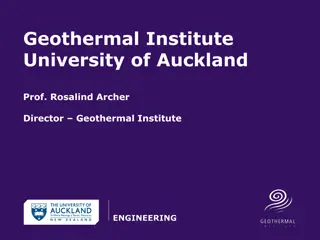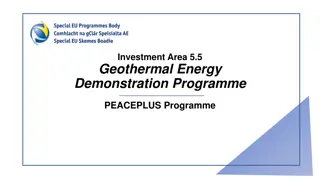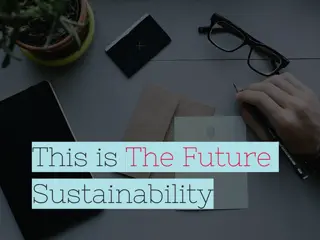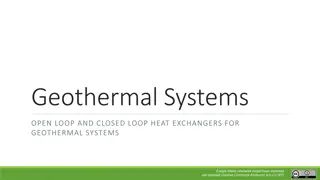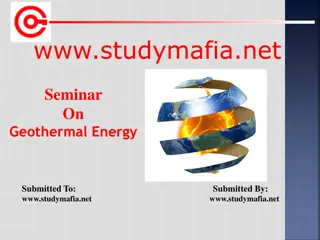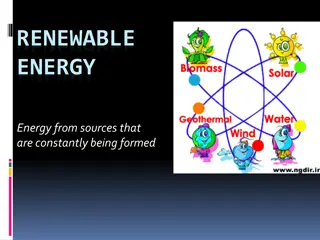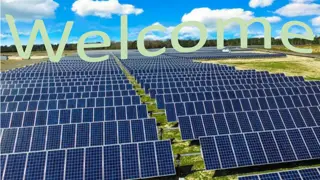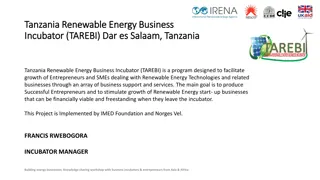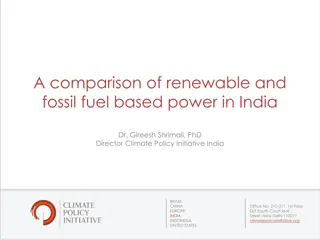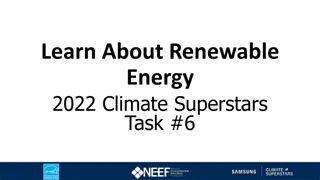Unveiling the Power of Geothermal Energy: A Deep Dive into Earth's Renewable Heat Source
Geothermal energy, originating from the Earth's core, offers a sustainable and accessible energy solution. This renewable resource, driven by high temperatures and pressures beneath the Earth's surface, can be harnessed through innovative technologies. Discover how geothermal energy - whether in the form of magma, steam, or dry heat - is tapped to generate electricity, heat structures, and provide a reliable energy alternative on a global scale.
Download Presentation

Please find below an Image/Link to download the presentation.
The content on the website is provided AS IS for your information and personal use only. It may not be sold, licensed, or shared on other websites without obtaining consent from the author.If you encounter any issues during the download, it is possible that the publisher has removed the file from their server.
You are allowed to download the files provided on this website for personal or commercial use, subject to the condition that they are used lawfully. All files are the property of their respective owners.
The content on the website is provided AS IS for your information and personal use only. It may not be sold, licensed, or shared on other websites without obtaining consent from the author.
E N D
Presentation Transcript
Energie Rinnovabili Laurea Magistrale in Chimica Lezione n.9 Federico Rosei Trieste, Marzo 2023 1
n.9 Geothermal energy 2
Geothermal Energy Thermal energy in the Earth s crust which originates from the formation of the planet & from radioactive decay of materials. High temperature & pressure in Earth s interior => rocks melt & solid mantle behaves plastically => parts of the mantle convect upward since it is lighter than the surrounding rock Temperatures at core-mantle boundary can exceed 4000 C Many countries have developed methods of tapping into geothermal energy. Different types of geothermal energy are available in different parts of the world. In Iceland, abundant sources of hot, easily accessible underground water make it possible for most people to rely on geothermal sources as a safe, dependable, and inexpensive source of energy. Other countries, such as the U.S., must drill for geothermal energy at greater cost. 3
About 2,900 kilometers (1,800 miles) below the Earths crust, or surface, is the hottest part of our planet: the core. A small portion of the core s heat comes from the friction and gravitational pull formed when Earth was created more than 4 billion years ago. However, the vast majority of Earth s heat is constantly generated by the decay of radioactive isotopes, such as potassium-40 and thorium-232. Radioactive decay is a continual process in the core. Temperatures there rise to more than 5,000 Celsius (about 9,000 Fahrenheit). Heat from the core is constantly radiating outward and warming rocks, water, gas, and other geological material. Earth s temperature rises with depth from the surface to the core. This gradual change in temperature is known as the geothermal gradient. In most parts of the world, the geothermal gradient is about 25 C per 1 kilometer of depth (1 F per 77 feet of depth). 4
If underground rock formations are heated to about 700-1,300 C (1,300- 2,400 F), they can become magma. Magma is molten (partly melted) rock permeated by gas and gas bubbles. Magma exists in the mantle and lower crust, and sometimes bubbles to the surface as lava. Magma heats nearby rocks and underground aquifers. Hot water can be released through geysers, hot springs, steam vents, underwater hydrothermal vents, and mud pots. These are all sources of geothermal energy. Their heat can be captured and used directly for heat, or their steam can be used to generate electricity. Geothermal energy can be used to heat structures such as buildings, parking lots, and sidewalks. Most of the Earth s geothermal energy does not bubble out as magma, water, or steam. It remains in the mantle, emanating outward at a slow pace and collecting as pockets of high heat. This dry geothermal heat can be accessed by drilling, and enhanced with injected water to create steam.5
Harvesting Geothermal Energy: Heating and Cooling Low-Temperature Geothermal Energy Almost anywhere in the world, geothermal heat (called low-temperature geothermal energy) can be accessed and used immediately. Low-temperature geothermal energy is obtained from pockets of heat about 150 C. Most pockets of low-temperature geothermal energy are found just a few meters below ground. Low-temperature geothermal energy can be used for heating greenhouses, homes, fisheries, and industrial processes. Low-temperature energy is most efficient when used for heating, although it can sometimes be used to generate electricity. People have long used this type of geothermal energy for engineering, comfort, healing, and cooking. Archaeological evidence shows that 10,000 years ago, groups of Native Americans gathered around naturally occurring hot springs to recuperate or take refuge from conflict. In the third century BCE, scholars and leaders warmed themselves in a hot spring fed by a stone pool near Lishan, a mountain in central China. One of the most famous hot spring spas is in the appropriately named town of Bath, England. Starting construction in about 60 CE, Roman conquerors built an elaborate system of steam rooms and pools using heat from the region s shallow pockets of low-temperature geothermal energy. 6
The hot springs of Chaudes Aigues, France, have provided a source of income and energy for the town since the 1300s. Tourists flock to the town for its elite spas. The low-temperature geothermal energy also supplies heat to homes and businesses. The United States opened its first geothermal district heating system in 1892 in Boise, Idaho. This system still provides heat to about 450 homes. Co-Produced Geothermal Energy Co-produced geothermal energy technology relies on other energy sources, using water that has been heated as a byproduct in oil and gas wells. In the United States, about 25 billion barrels of hot water are produced every year as a byproduct. In the past, this hot water was simply discarded. Recently, it has been recognized as a potential source of even more energy: Its steam can be used to generate electricity. One of the first co-produced geothermal energy projects was initiated at the Rocky Mountain Oilfield Testing Center in Wyoming. Newer technology has allowed co-produced geothermal energy facilities to be portable. Although still in experimental stages, mobile power plants hold tremendous potential for isolated or impoverished communities. 7
Geothermal Heat Pumps Geothermal heat pumps (GHPs) take advantage of the Earth s heat, and can be used almost anywhere in the world. GHPs are drilled about 3 to 90 meters (10 to 300 feet) deep, much shallower than most oil and natural gas wells. GHPs do not require fracturing bedrock to reach their energy source. A pipe connected to a GHP is arranged in a continuous loop called a "slinky loop" that circles underground and above ground, usually throughout a building. The loop can also be contained entirely underground, to heat a parking lot or landscaped area. In this system, water or other liquids (such as glycerol, similar to a car s antifreeze) move through the pipe. During the cold season, the liquid absorbs underground geothermal heat. It carries the heat upward through the building and gives off warmth through a duct system. These heated pipes can also run through hot water tanks and offset water-heating costs. 8
Harvesting Geothermal Energy: Electricity In order to obtain enough energy to generate electricity, geothermal power plants rely on heat that exists a few kilometers below the surface of the Earth. In some areas, the heat can naturally exist underground as pockets steam or hot water. However, most areas need to be enhanced with injected water to create steam. Dry-Steam Power Plants Dry-steam power plants take advantage of natural underground sources of steam. The steam is piped directly to a power plant, where it is used to fuel turbines and generate electricity. Dry steam is the oldest type of power plant to generate electricity using geothermal energy. The first dry-steam power plant was constructed in Larderello, Italy, in 1911. Today, the dry-steam power plants at Larderello continue to supply electricity to more than a million residents of the area. There are only two known sources of underground steam in the United States: Yellowstone National Park in Wyoming and The Geysers in California. Since Yellowstone is a protected area, The Geysers is the only place where a dry-steam power plant is in use. It is one of the largest geothermal energy complexes in the world, and provides about a fifth of all renewable energy in California. 9
Flash-Steam Power Plant Flash-steam power plants use naturally occurring sources of underground hot water and steam. Water that is hotter than 182 C (360 F) is pumped into a low- pressure area. Some of the water flashes, or evaporates rapidly into steam, and is funneled out to power a turbine and generate electricity. Any remaining water can be flashed in a separate tank to extract more energy. Flash-steam power plants are the most common type of geothermal power plants. The volcanically active island nation of Iceland supplies nearly all its electrical needs through a series of flash-steam geothermal power plants. The steam and excess warm water produced by the flash-steam process heat icy sidewalks and parking lots in the frigid Arctic winter. The islands of the Philippines also sit over a tectonically active area, the "Ring of Fire" that rims the Pacific Ocean. Government and industry in the Philippines have invested in flash-steam power plants, and today the nation is second only to the United States in its use of geothermal energy. In fact, the largest single geothermal power plant is a flash-steam facility in Malitbog, Philippines. 10
Binary Cycle Power Plants Binary cycle power plants use a unique process to conserve water and generate heat. Water is heated underground to about 107 -182 C (225 -360 F). The hot water is contained in a pipe, which cycles above ground. The hot water heats a liquid organic compound that has a lower boiling point than water. The organic liquid creates steam, which flows through a turbine and powers a generator to create electricity. The only emission in this process is steam. The water in the pipe is recycled back to the ground, to be re-heated by the Earth and provide heat for the organic compound again. The Beowawe Geothermal Facility in the U.S. state of Nevada uses the binary cycle to generate electricity. The organic compound used at the facility is an industrial refrigerant (tetrafluoroethane, a greenhouse gas). This refrigerant has a much lower boiling point than water, meaning it is converted into gas at low temperatures. The gas fuels the turbines, which are connected to electrical generators. 11
Enhanced Geothermal Systems The Earth has endless amounts of energy and heat beneath its surface. However, it is not possible to use it as energy unless the underground areas are "hydrothermal. : They must be hot, but also contain liquid and are permeable. Many areas do not have all three components. An enhanced geothermal system (EGS) uses drilling, fracturing, and injection to provide fluid and permeability in areas that have hot but dry underground rock. To develop an EGS, an injection well is drilled vertically into the ground. Depending on the type of rock, this can be as shallow as 1 kilometer to as deep as 4.5 kilometers. High-pressure cold water is injected into the drilled space, forcing the rock to create new fractures, expand existing fractures, or dissolve. This creates a reservoir of underground fluid. Water is pumped through the injection well and absorbs the rocks heat as it flows through the reservoir, is then piped back up to Earth s surface through a production well. The hot water warms a secondary fluid that has a low boiling point, which evaporates to steam and powers a turbine. It then cools off, and cycles back down through the injection well to absorb underground heat again. There are no gaseous emissions besides the water vapor from the evaporated liquid. Pumping water into the ground can cause seismic activity, or small earthquakes. 12
Geothermal Energy and the Environment Geothermal energy is a renewable resource. The Earth has been emitting heat for about 4.5 billion years, and will continue to emit heat for billions of years because of the ongoing radioactive decay in the Earth s core. However, most wells that extract the heat will eventually cool. Larderello, Italy, site of the world s first geothermal electrical plant, has seen its steam pressure fall by more than 25% since the 1950s. Re-injecting water can sometimes help a cooling geothermal site last longer. However, this process can cause micro-earthquakes. Although most of these are small, sometimes the ground can quake at more threatening levels and cause the geothermal project to shut down. Geothermal systems do not require enormous amounts of freshwater. In binary systems, water is only used as a heating agent, and is not exposed or evaporated. It can be recycled or released into the atmosphere as non-toxic steam. However, if the geothermal fluid is not contained and recycled in a pipe, it can absorb harmful substances (arsenic, boron, and fluoride), which can be carried to the surface and released when the water evaporates. If the fluid leaks to other underground water systems, it can contaminate clean sources of drinking water and aquatic habitats. 13
Advantages Geothermal energy is renewable. The Earth is continuously radiating heat out from its core, and will continue to do so for billions of years. Some form of geothermal energy can be harvested anywhere in the world. Using geothermal energy is relatively clean. Most systems only emit water vapor; some emit very small amounts of sulfur dioxide, nitrous oxides, and particulates. Geothermal power plants can last for decades, possibly centuries. If a reservoir is managed properly, the amount of extracted energy can be balanced with the rock s rate of renewing its heat. Unlike other renewables, geothermal systems are baseload. : they can work in the summer or winter, and are not intermittent. Geothermal power plants produce electricity or heat 24/7. The space it takes to build a geothermal facility is comparatively very compact. To produce a GWh, a geothermal plant uses the equivalent of about 1,046 square kilometers of land; wind energy requires 3,458 square kilometers, a solar farm requires 8,384 square kilometers, coal plants use about 9,433 square kilometers. Geothermal energy systems can be used to heat, cool, or power individual homes, whole districts, or industrial processes. 14
Disadvantages Harvesting geothermal energy still poses many challenges: The process of injecting high-pressure streams of water into the Earth can result in minor seismic activity, or small earthquakes. Geothermal plants have been linked to subsidence, or the slow sinking of land. This happens as the underground fractures collapse upon themselves. This can lead to damaged pipelines, roadways, buildings, and natural drainage systems. Geothermal plants can release small amounts of greenhouse gases such as hydrogen sulfide and carbon dioxide. Water that flows through underground reservoirs can pick up trace amounts of toxic elements such as arsenic, mercury, and selenium. These harmful substances can be leaked to water sources if the geothermal system is not properly insulated. Although the process requires almost no fuel to run, the initial cost of installing geothermal technology is expensive. Developing countries may not have the sophisticated infrastructure or start-up costs to invest in a geothermal power plant. Several facilities in the Philippines, for example, were made possible by investments from American industry and government agencies. Today, the plants are Philippine-owned and operated. 15











